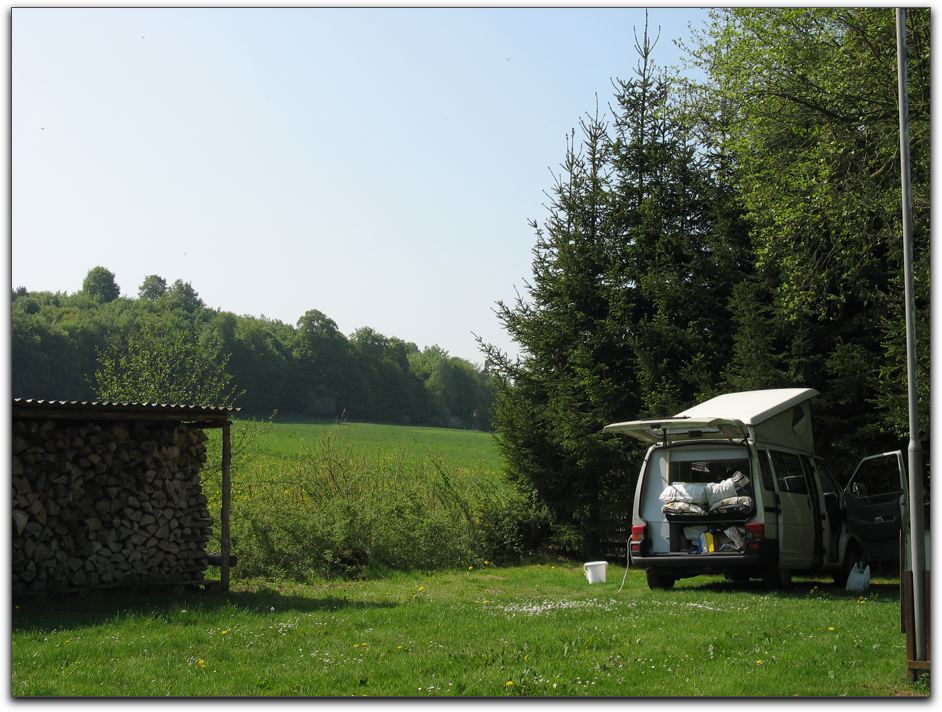
in the region known as Hesse… (as in "Herman", though there seems to be no connection.) in order to be on our way to Hameln.
After leaving Mainz we drove a few hours and camped in Alsfeld-West, in hilly farm country north of Frankfurt

in the region known as Hesse… (as in "Herman", though there seems to be no connection.) in order to be on our way to Hameln.
We found the lovely and picturesque old timber houses in Alsfeld. As we wandered the old town, known as Altstadt. we enjoyed the active and charming open air market.
We then told Gertrude (our gps) to get us to Hameln by the quickest route. We drove through quite beautiful fields of rapeseed,

then drove on to Hameln.
We arrived just in time for the 5:00 PM Shabbat service, after finding the street but having difficulty locating the number we needed. Mark checked in a store, where the man who looked like mishpocha on the Hurvitz side, directed him to the Internet café down that block, where they said "Oh the Judische Gemeinde. It's right behind here."
This was one of the few times we had an easy time finding an Internet café… They even had wireless. But we weren't in a position to use it. it.
We pulled in, located the president/founder Rachel Dohme, checked a few details for the service and started. Rachel welcomed us and some other guests, announced pages and also helped lead the tefillot in German and Hebrew.
Afterwards we all enjoyed a full Oneg Shabbat of cookies, cake, sandwiches, wine, mineral water, all seated together. The group's social worker played some well known Yiddish and Hebrew folk songs and Mark joined in on his new recorder.

We took this photo after a number of people had already left. The group meets in an office space rented from the city.
After studying medicine in Cologne and meeting his future wife, Sabine Elze, Dr. Siegmund Kratzenstein moved to Hameln and set up his GP practice in 1903. The couple had 2 sons, Ernst and Leon. During WWI, Dr. Kratzenstein served his country by caring for Russian POWs and received the German Medal of Honor for his service.
In 1931, Dr. Kratzenstein's practice thrived, he bought a home and was known throughout the city. He was well-respected and loved, both by Christian and Jewish patients. He was the school doctor, responsible for all the city's public school students. Dr. Kratzenstein was known for his acts of loving kindness and social responsibility, not charging poorer patients.
On April 22, 1933, with the Nazis in power, a boycott of Jewish professionals was put into force and Dr. Kratzenstein was no longer allowed to practice medicine as a doctor. His title was reduced to "caretaker". He was 57 years old.
He realized what was happening in Germany and made provisions to immigrate to Palestine. He learned Hebrew and English and taught others. In 1937 he accepted the position of the (last) president of the Jewish Congregation of Hameln.
Pogrommnacht-November 9, 1938. The Nazis destroyed Jewish businesses and homes, desecrated the Jewish cemetery and dragged 10 Jewish men from their homes,including Dr. Kratzenstein. They forced them to watch the synagogue (designed by architect Edwin Oppler in 1879) burn to the ground. The men were then taken by force to Buchenwald. One of the youngest men, died there of abuse. Dr. Kratzenstein survived the 1 month internment, only to die in Hameln on November 28, 1938. He was secretly (because Jews were not permitted to be buried - even in Jewish cemeteries) buried in the Jewish cemetery on a cold and rainy November night at midnight.

The presumed location of the grave is against the wall by the "bleached" section.
The young man who buried him, Josef Speckmann, now (in 2006) 75, recently came forward to tell the story and identify the grave. Rachel has been in contact with Dr. Kratzenstein's relatives and the congregation hopes finally to set a stone for him before the High Holy Days 2006.
Josef Speckmann has not been recognized by Yad Vashem as one of the "Righteous Among the Nations"; he won't allow it as he feels that he did not do enough.

We're not quite sure which is the home of Glückel...:

And, while on the subject of Glückel, we should round out some circles and mention Bertha Pappenheim. Bertha is best known as Anna O. of Vienna. We also saw a portrait of her in the Jewish Museum in Berlin in which she posed as Glückel. This was in part, we suspect, an expression of her strong Jewish feminism about which less is known.
As reported above, Mark played his recorder with the congregation. During our tour of the city, he had his photo taken beside a more famous piper.

No adverse results have been reported.